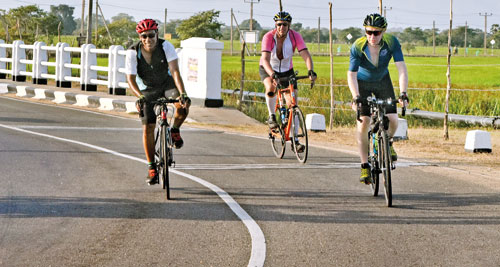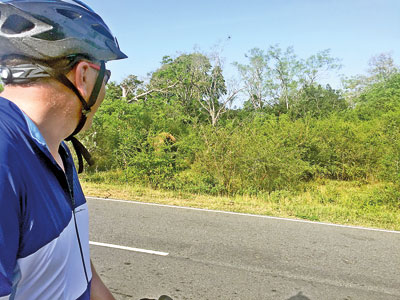‘Heart’ riders

In a race against the sun and heat:From left, Dr. Divaka Perera, Prof. Michael Marber and Dr. Peter O’ Kane
Everything was well-planned, or so they thought, to the last detail.
As they set off, there was not only purposeful commitment and determination, for they had come from half a world away to cycle from Sri Lanka’s south to north, to help keep the diseased hearts of little ones beating. They were also aware of the challenges ahead, the merciless heat and the fatigue.
There was much fun and ribbing among the core eight-member team comprising Dr. Divaka Perera, Prof. Michael Marber, Dr. Peter O’Kane, Dr. Rob Daniels and Shamindra Perera from England and Sanjay Kulatunga, Channa Daswatte and Manju Sirimane who joined them from Sri Lanka.
The stretch was from Kataragama to Buttala on the jungle-fringed B-35 Road and they were literally sailing along in their vibrant attire and helmets in the early morn, when suddenly something caught their eye.
Stopped short in their tracks, they held a whispered consultation ……should they whiz past at high speed on their cycles or dismount and tiptoe quietly past?
For, totally at ease was an unexpected ‘bystander’ – not to cheer them on, escort them or ride with them.
It was a wild elephant leisurely foraging by the side of the road!
They dared not ride speedily past, so they “gingerly” walked past the “magnificent chap”.

The ‘unexpected’ bystander past whom Dr. Rob Daniels “gingerly” tiptoed past
Back in Colombo, chatting over tea and butter cake at the Lady Ridgeway Hospital (LRH) for Children in Borella, a day before leaving Sri Lanka, for these ‘cyclists’ this and many more would be treasured memories. I am tempted to ask, but refrain, whether they were shivering in their sports shoes, with their knees knocking so loud that the elephant may very well have heard them and felt sorry for them, allowing them to pass unharmed.
In England, three of them are into hearts – Dr. Perera, originally from Sri Lanka, is an Interventional Cardiologist at Guy’s and St Thomas’ Hospital London; Prof. Marber is Professor of Cardiology at King’s College London; and Dr. O’Kane is an Interventional Cardiologist at Royal Bournemouth Hospital; while Dr. Daniels is a General Practitioner in Devon and Shamindra, brother of Dr. Perera, is a fund manager in London. In the ‘Colombo team’, Sanjay is Chairman of Lynear Wealth Management, one of the sponsors of Cardiac Cycle Lanka; Channa is a well-known architect; and Manju, a lawyer.
It is because hearts are their passion that they wanted to do something more than the good work of healing hearts in England and launched ‘Cardiac Cycle Lanka’ to raise funds for the Little Hearts Project, a Sri Lanka government-approved charitable initiative of the Sri Lanka College of Paediatricians and also the British Heart Foundation (BHF) to help the international fight against heart disease.
The ‘mission’ with a heart was flagged-off from Dondra on June 11, taking the eastern sea route on a 750-km charity bicycle ride over nine days, ending in Point Pedro on June 19. A ‘token’ ride was held at midday on June 10 from the Galadari Hotel to the Galle Face Hotel at the start of the Sri Lanka Heart Association’s scientific meeting.
“On our actual ride we knew it would be very hot, much too hot to do any cycling as the day advanced,” laughs Dr. Perera. This was why they planned to set off very early, some days even around 4.30 a.m. and travelled along with their head-lamps lighting up the surrounding darkness.

The whole team at the Dondra lighthouse at dawn, day one: From left, Pradeep, Shamindra, Manju, Rob, Sanjay, Channa, Mike, Divaka and Pete
The others explain how the decision was made on the run to begin early morn when they felt tired by the second day.
Dr. Daniels waxes eloquent on the “great” sunrises of the east coast, while Prof. Marber smiles how it was like a race against the sun and Dr. O’Kane nods vigorously recalling how it became “very hot” as the morning advanced.
In a few days, the team got into a routine and all of them chuckle as Dr. Daniels talks of how children, especially girls, would race them until they reached their school gate. We were able to ‘read’ the time, without looking at our watches, he says, adding that the ‘stirring’ of village and townsfolk gave them the pointers.
The team managed to pass the wild elephant without much mishap, but the dogs were the worst, says Dr. Daniels and the modus operandi in warding them off was “to keep cycling and also ‘bark’ back at them”. So they became ‘top dogs’ and according to Prof. Marber most probably the dogs assumed they were “more dominant dogs”.
In Arugam Bay, they met head-on with a cloud of insects, says Dr. O’Kane and Dr. Daniels relives a “near-accident” with a fruit bat.
As they moved northward, the heat became sweltering making the dogs less active and they marvel at the “quality” of the roads. Only two tyre punctures did they experience though they expected more, while they saw village and town life to their fullest and much wildlife including peacocks and other birdlife.
These colourful riders did get some looks of wonder and amazement in some villages, where they passed by rural workers getting about their daily tasks of eking out a living, using push-cycles as their mode of transport. Batticaloa saw them weaving through three-wheelers, says Dr. O’Kane, sometimes becoming traffic stoppers and Prof. Marber identifies buses as the “main hazard” and Dr. Perera creates an image of the danger with buses not only going on their side of the road but at other times also on the wrong side.
Gradually, a pattern emerged, starting their rides with a fruit meal of luscious pineapple, papaya and banana and coffee, with the ‘reward’ at the end of an arduous lap being the “best sight” of a big plate of string-hoppers with red chillie-hot sambol at mid-morning.
“Yes, it did give me heartburn,” smiles Prof. Marber but it didn’t deter him from tucking into the fare.
Intrigued as to whether they are regular cyclists back in England, we are told with a snigger that most of them had done so 25 years before as students. Many at the Heart Association sessions had expressed serious doubts and skepticism whether slightly senior Prof. Marber would be able to make it to the finish line, but what they were unaware of was that he was the “most experienced”, riding 50kms every day.
The others began their training-rides in earnest in October last year in preparation for this gruelling mission, competing with each other on apps, with the biggest motivation coming from this competition. They concede that the Colombo team got stronger, faster and faster and better and better.
 Encouraged by the enthusiasm along the way, rousing had been the welcome as they reached Point Pedro, for several of the doctors there had trained or worked with these British heart specialists.
Encouraged by the enthusiasm along the way, rousing had been the welcome as they reached Point Pedro, for several of the doctors there had trained or worked with these British heart specialists.
The escorts were marvellous, says the team, adding that the police went ahead of them from the south to the east coast and in Matara and Jaffna schoolchildren lined the streets and waved them on, while in Point Pedro a large number of schoolchildren rode along with them, with their cycles sporting little flags with red hearts on them.
For the organizers though there were some heart-stopping moments because the cycling team sometimes had to travel without an ambulance accompanying them. Fortunately, there were no serious issues which necessitated dismounting the bikes and boarding an ambulance.
A very memorable meeting had been when their paths crossed that of the Pada Yatra pilgrims and the cycling team instinctively felt that like the devotees they were gaining ‘good karma’.
These are the wonderful feelings that they take back with them as they resume their routines in England, with a poignant meeting of a father of a seven-year-old child. While thanking them for their good deeds, he tearfully describes how the LRH’s heart team pulled his son back from the brink of death, just two days after birth.
As Dr. Perera asks, “Babata den kohomada”, Malidu Induwara’s father, R.S. Wijeratne says: Doctors lage pihiten mage baba beruna.
While Malidu is in Ward 7 for a check-up, having donated his till into which he had dropped a few rupees each day, to the ‘Little Hearts’ Project, there is humour when his father says that Malidu cycles to school every day.
You too can help
While the heart doctors came all the way from England to face the cycling marathon and raise funds, a plea goes out from the Little Hearts Sri Lanka Project Chairperson and Consultant Paediatric Cardiologist Dr. Duminda Samarasinghe.
“You too can help,” he says, reiterating that every rupee counts.
Generous donors could send their contributions to the Bank of Ceylon Account No. 79738633 with the Account Name: ‘Little Hearts’ at the Borella branch. Secure online donations may also be made through the website: www.littlehearts.lk.
For more details, please contact the hotline: 0716441122
Another way to channel your donations would be through http://CardiacCycleLanka.com
For, the need is great and it is a national need – a Cardiac and Critical Care Complex, a centre of excellence, for very-ill children with severe heart disease to be established at the premier children’s hospital in the country, the LRH. This is the only tertiary-care referral centre for all those little patients ranging from newborns to 12-year-olds.
The vision is a dedicated 10-storey state-of-the-art building for children with heart trouble as well as other severe illnesses and the target is to collect Rs. 2 billion. Prof. Michael Marber underscores that if you fix the hearts of little ones, they would have a very long and productive life ahead of them.
The Cardiac Cycle Lanka team, meanwhile, collected funds through a sponsorship programme, having a website with a ‘donation portal’.
They are supporting two charities, Little Hearts Sri Lanka and the British Heart Foundation, the largest independent funder of cardiovascular research in the United Kingdom with the vision of ‘a world in which people do not die prematurely or suffer from cardiovascular disease’. “With the option of selecting one or the other, it is interesting that the British donors predominantly chose Little Hearts,” says Dr. Divaka Perera.
They have raised a total of Rs. 5 million so far, of which Rs. 4 million has gone to Little Hearts Sri Lanka.


